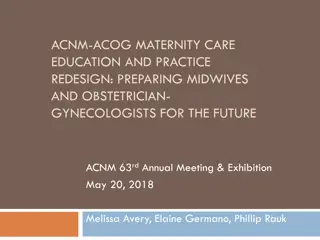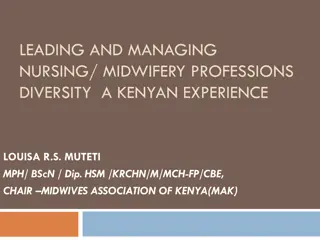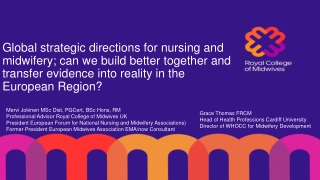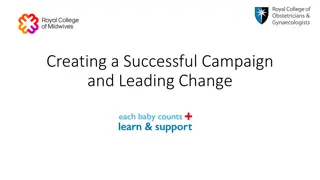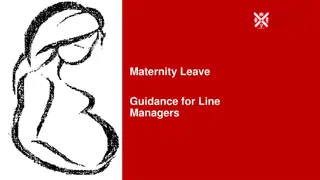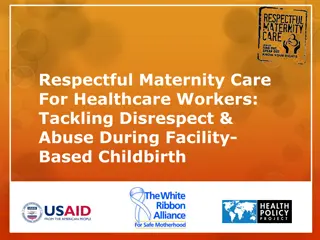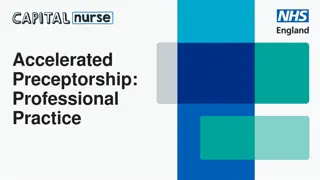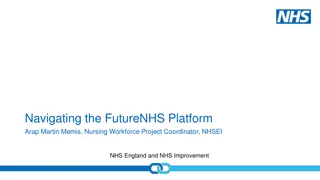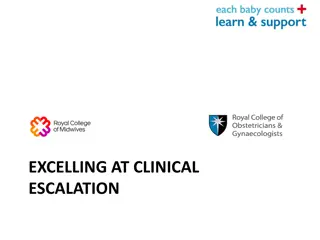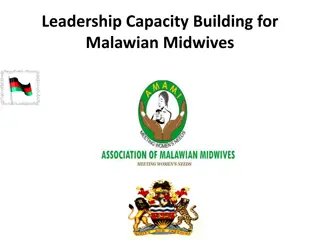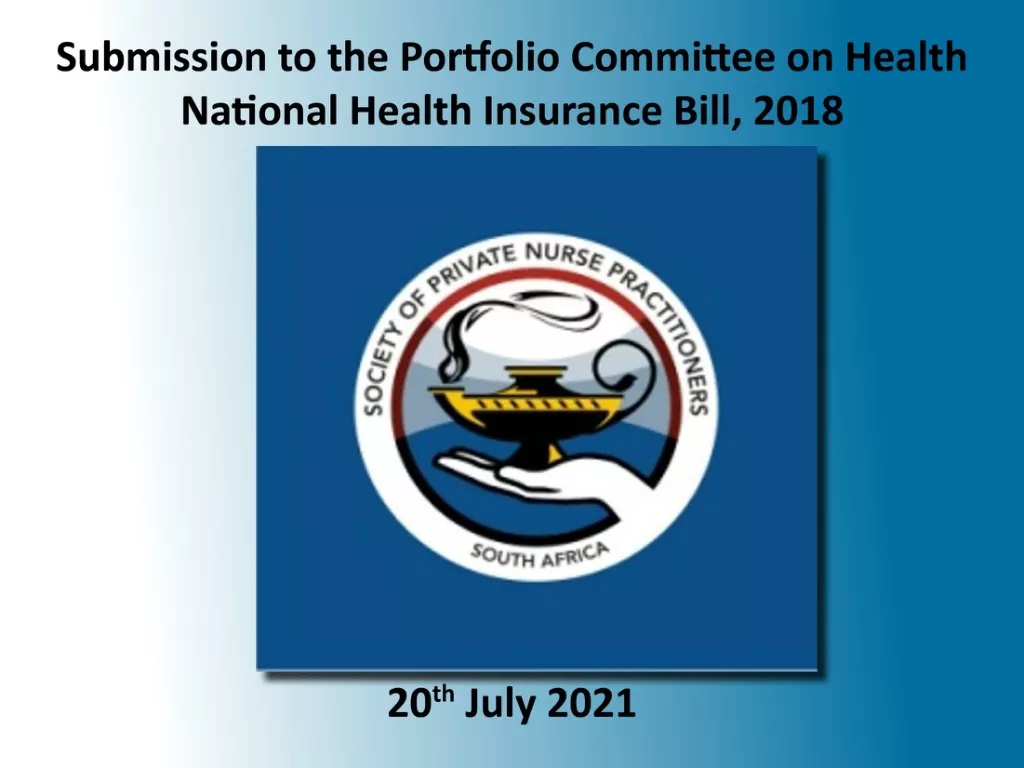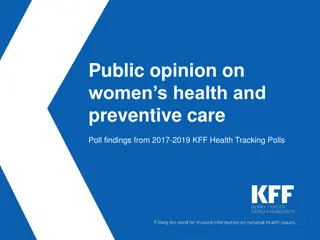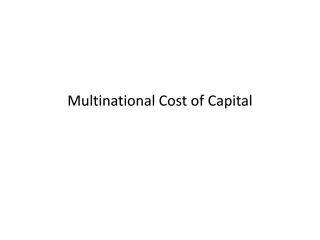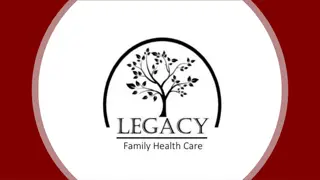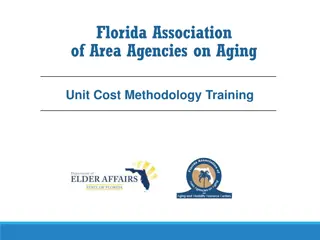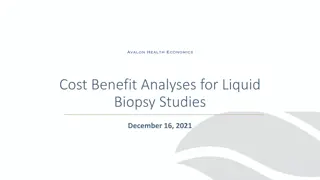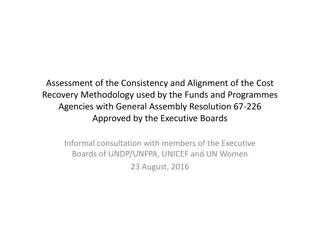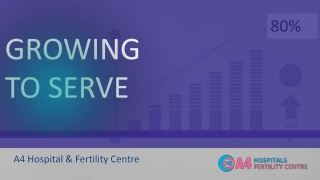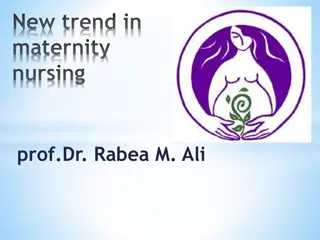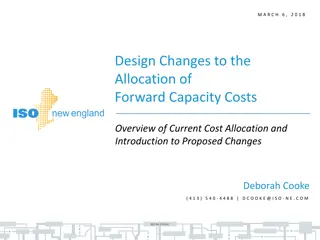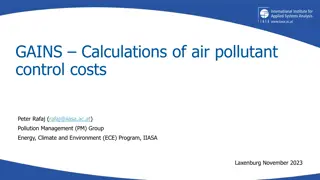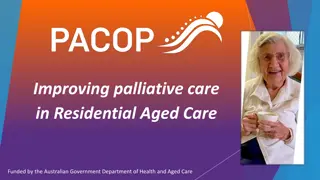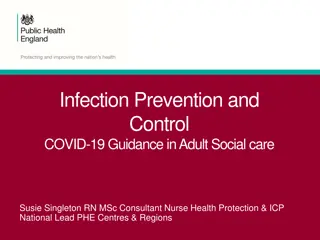Midwifery: A Cost-effective Solution for US Maternity Care
Midwifery presents a cost-effective solution for maternity care in the US, offering excellent outcomes and addressing the mismatched workforce. The current state of maternity care reveals the significance of midwives in managing low to moderate-risk pregnancies. With a projected shortage of OB/GYNs, midwives could address 90% of essential needs in maternal, newborn, and reproductive health. Disparities in maternal mortality rates between the US and other developed countries highlight the importance of integrating midwifery into the healthcare system.
Download Presentation

Please find below an Image/Link to download the presentation.
The content on the website is provided AS IS for your information and personal use only. It may not be sold, licensed, or shared on other websites without obtaining consent from the author. Download presentation by click this link. If you encounter any issues during the download, it is possible that the publisher has removed the file from their server.
E N D
Presentation Transcript
MIDWIFERY A COST-EFFECTIVE SOLUTION FOR US MATERNITY CARE
This presentation will: 1. Provide an overview of current state of maternity care in the US OBJECTIVES 2. Review current maternity care payment models 3. Identify excellent outcomes and cost-effectiveness of midwifery 4. Discuss tangible opportunities for improved US maternity care
#1 reason for hospitalization in the US is childbirth (ahrq.gov, 2022) STATE OF MATERNITY CARE IN THE US #1 inpatient surgery in the US is C Section (1,167,660 C Sections in 2018) (ahrq.gov, 2022) #1 most common Hospital Discharge in US is for Childbirth (3,612,999 hospital discharges in 2018) Source: hcupnet.ahrq.gov (2022)
Vast majority of pregnant women in US, pregnancy follows a routine physiological course and are considered low-risk or moderate-risk pregnancies 6-8% of pregnancies in the US are high-risk STATE OF MATERNITY CARE IN THE US Current makeup of US Maternity care providers: - OB/GYN s attend 90% of hospital births in US in 2020 - Midwives attend about 10% of hospital births in US Projected shortage of up to 22,000 OB/GYN s by 2050 SUPPLY & DEMAND OB/GYNs are surgical specialists trained to care for high-risk pregnancies Midwives are licensed specialists trained to care for low & moderate risk pregnancies 90% of essential needs in maternal, newborn, and reproductive health could be addressed by midwives Bottom Line = Mismatched maternity care workforce in US Sources: UCSF High-risk Pregnancy; ACNM, 2022; Rosenberg, 2019; UNFPA, WHO, ICM, 2021
Sources: UCSF High-risk Pregnancy; ACNM, 2022; Rosenberg, 2019; UNFPA, WHO, ICM, 2021 CURRENT STATE OF MATERNITY CARE IN THE US 10% Mismatched workforce to meet US childbirth demands 6-8% of US US births in hospitals by Midwives pregnancies (high-risk) 90% US births attended by OB-GYNs (surgeons trained to treat high-risk patients) Vast majority of pregnancies in US (low-risk to moderate-risk)
US Maternity care compared to other developed countries in 2018 Sources: Roper, 2020; Tikkanen et al, 2020; OECD Health Data 2020 2018 Maternal Mortality rates (deaths for every 100K births) US 17.4 NETH 3 GER 3.2 UK 6.5 NOR 1.8 SWE 4.3 AUS 4.8 0 5 10 15 20 Maternal Mortality (# Deaths for every 100,000 live births)
C section rates went from 5.5% in 1970 to 32.1% of all US births in 2021 CURRENT MATERNITY CARE OUTCOMES IN THE US Primary low-risk C section rates 26.3% in 2021 in the US Preterm birth rates 10% of newborns born prematurely in 2020 The US maternal mortality rate for 2021 was 32.9 deaths/100,000 live births, up from 23.8 deaths/100,000 live births in 2020, compared with a rate of 20.1 in 2019, and 17.4 in 2018. CDC, 2022 4 of 5 Pregnancy related deaths are preventable Recent CDC report 80% Maternal deaths are preventable US Women are more-likely to die from pregnancy- related reasons as compared to all other high-income developed countries Sources: Hoyert, 2023, 2022, 2021, 2020; Chinn, 2020; Mann et al, 2018; Osterman et al, 2023
Disparities in Maternal Mortality in the US In 2021, the maternal mortality rate for non- Hispanic Black women was 2.6 times the rate for non- Hispanic White women (Hoyert, 2023) Worsening maternal mortality rates in US (Hoyert, 2023) Source: Hoyert et al, 2023
CONTINUUM OF MATERNITY CARE IN THE US Day of Delivery 1-6 days Postpartum 7-42 days Postpartum 43-365 days Postpartum During Pregnancy Timing of pregnancy-related deaths (2017-2019) 30% 23.30% 21.60% 13.20% 12% DURING PREGNANCY DAY OF DELIVERY 1-6 DAYS POSTPARTUM 7-42 DAYS POSTPARTUM 43-365 DAYS POSTPARTUM During Pregnancy Day of delivery 1-6 days postpartum 7-42 days postpartum 43-365 days postpartum 53% deaths occurred 7-365 days postpartum Source: Trost et al, 2022
Pregnancy-related Deaths (2017- 2019) PREGNANCY RELATED DEATHS IN THE US 22% 53% 25% CDC, 2022 4 of 5 Pregnancy related deaths are preventable Day of delivery - 7 days after delivery 7 days after delivery - 1 year after Pregnancy Source: Trost et al, 2022; Hoyert et al, 2022
Maternity Care Deserts - 35% of counties in the US are maternity care deserts with neither a hospital maternity unit, nor any obstetrician- gynecologist or certified nurse midwife US MATERNITY CARE DESERTS (2020) Women are about 60% more likely to die from pregnancy related causes in US Maternity Care Deserts Maternal mortality ranges from 10.1 deaths/100,000 births in California to 43.5 deaths/100,000 births in Arkansas Sources: Brigance et al, 2022; Wallace et al, 2021; March of Dimes, 2022; CDC MMWR 2018-2021
Our vision for the future is that the United States will be considered the best country in the world to have a baby. -Biden-Harris Administration, 2022
Maternity Care global routine care for pregnant patients, which includes prenatal, birth, and postpartum care (through 42 days postpartum) Providers are typically reimbursed a bundled payment for the total provider services from the initial diagnosis of the pregnancy until the end of the postpartum period PAYMENT MODELS FOR MATERNITY CARE IN US Medicaid covers 41% of births in US Private insurance covers 51.7% of births in US Maternity Care Payments in US Remaining 7-8% of US births covered by TRICARE, Indian Health Services, charity, self-pay, or uninsured Medicaid bundled reimbursement amounts are less than private insurance bundle reimbursement amounts, for both vaginal births and c sections 8% Private insurance Medicaid 51% 41% In many states, bundled reimbursement payments are less than prenatal care costs alone Bottom line = hospitals frequently lose $ on maternity care, especially from Medicaid-insured patients Sources: Martin et al, 2022; Osterman et al, 2023; Baker et al, 2021; Truven Health Analytics, 2013; Ins for Medicaid Innovation, 2020; Johnson et al, 2020
About 4 in 5 of all dollars paid on behalf of maternal and newborn care go to the facility and other payments for the relatively brief hospital phase of care PAYMENT MODELS FOR US MATERNITY CARE Just 1 in 5 of all $ paid for Maternity Care goes to prenatal and postnatal care Reimbursement from private insurance companies & Medicaid does not cover the costs for postpartum care after 42 days Yet, 53% of pregnancy-related deaths in the US occur from 7days 1 year postpartum. Hospital maternity care units are closing, due to losing $ on maternity care CONTINUUM OF MATERNITY CARE IN THE US Day of Delivery 1-6 days Postpartum 7-42 days Postpartum 43-365 days Postpartum During Pregnancy 4 of 5 of all $ paid for Maternity care 53% deaths occurred 7- 365 days postpartum Sources: Baker et al, 2021; Truven Health Analytics, 2013; Ins for Medicaid Innovation, 2020; Johnson et al, 2020
Overview of midwifery MIDWIFERY Benefits/Outcomes of midwifery Cost-effectiveness of midwifery
The American College of Nurse-Midwives (ACNM) is the professional association representing certified nurse- midwives (CNMs) and certified midwives (CMs) in the United States CNMs are licensed, independent health care providers with prescriptive authority in all 50 states, the District of Columbia CNMs and CMs are defined as primary care providers under federal law MIDWIFERY PRACTICE IN THE US CNMs are APRNs who are specialized in physiologic birth, trained to provide care for low-risk and moderate-risk pregnancies CNMs are registered nurses who obtain additional graduate education to become CNMs. CMs also have graduate degrees In addition to birthing care, services provided by CNMs/CMs include annual exams, writing prescriptions, basic nutrition counseling, parenting education, patient education, and reproductive health visits Sources: ACNM, 2022; ACNM Core Data Survey 2019
2016 Cochrane review compared midwifery-led care to other models of care for childbearing women and their infants Midwife-led care associated with less regional analgesia, less preterm births, and more likely for spontaneous vaginal birth (less c sections) BENEFITS OF MIDWIFERY Women who had midwife-led care reported higher rates of maternal satisfaction There was also a trend towards cost-saving as compared to other models of care Midwifery-led care shows evidence of strengthening health systems, including building their workforce, makes the difference in reversing maternal morbidity & mortality Since 1990, the 21 countries most successful in reducing maternal mortality rates by at least 2.5% a year have done this by deploying midwives (Lancet series, 2014) Sources: Sandall et al, 2016; Attanasio et al 2020; ICM/UNFPA/WHO 2021; Renfrew et al, 2014; Souter et al, 2019
Less $ to train and deploy Midwives into workforce Less expenses during intrapartum care (less medical and surgical interventions) 2019 Policy Brief estimated costs and clinical outcomes associated with midwife-led versus OB-led Maternity care COST- If midwifery-led care increased from 9% to 20% in US, it would result in $4 billion in cost savings by year 2027 EFFECTIVENESS OF MIDWIFERY Sources: Kozhimannil, 2019 (Table used with permission)
Childbirth is the most common reason for hospitalization in the US NEED FOR IMPROVEMENT C sections are increasing, and are the #1 surgery in hospitalized patients in the US Maternal morbidity & mortality is worsening in the US, with wide disparities across the United States Reimbursement for maternity care does not fully cover the costs incurred throughout the continuum of maternity care Workforce improvements Hospital maternity care units are closing, due to losing $ on maternity care Tangible Opportunities for Improved US Maternity Care Maternity care deserts (35% of all US counties) limited access to high-demand maternity care in the US Current state of US Maternity care not meeting the needs of pregnant women in the US, with worsening outcomes Payment improvements Bottom line = Urgent need to improve quality and value of US Maternity care
Current maternity care reimbursement model (fee-for-service model) hospitals in the US lose money & consequently close maternity care units Unintended repercussions of bundled payment models for maternity care have led to limited access to maternity care TANGIBLE OPPORTUNITIES FOR IMPROVEMENT Current payment models fragmented with focus on pathology, postpartum care is sporadic especially for women with limited resources and gaps in insurance coverage Need for adequate reimbursement for maternity care services that continues through 1 year postpartum PAYMENT IMPROVEMENTS Adequate reimbursement models for both Medicaid and private insurance payers (the 2 main payers of maternity care in US) Missing periods of greatest risk during maternity care cycle Evidence shows the midwifery is cost-effective, affordable, and sustainable (similar return on investment of cost per death averted by vaccines) - Lancet series, 2014 Sources: Truven Health Analytics, 2013; ACOG 2014; Renfrew et al, 2014; Yu & Feldman, 2021
Value-based payment an alternative payment model with linkage to quality, value, and health equity Payment changes, like value-based payment, would pay for value/quality of care & reduce health disparities TANGIBLE OPPORTUNITIES FOR IMPROVEMENT Fee-for-service payment models are outdated, inefficient, and accelerate disparities in maternal care Social determinants of health impact patients health outcomes Value-based payment models may reduce the frequency of unnecessary interventions and decrease costs of maternity care PAYMENT INNOVATIONS Value-based payment models would integrate maternity care with social services at the local, state, and federal levels Increased midwife utilization in value-based models would lead to high-quality and affordable prenatal, labor, and postpartum care Sources: Werner et al, 2021; Agarwal et al, 2020; Murray Horwitz, 2018
AIM (Alliance for Innovation on Maternal Health) collaboration led by ACOG and 30 organizations, which have created bundles of best practices for maternity care & 3 most common preventable causes of pregnancy-related death TANGIBLE OPPORTUNITIES FOR IMPROVEMENT Implementation of AIM bundles in all states / birthing centers goal to reduce maternal morbidity and mortality through improvement strategies HRSA s Nurse Corps program, which provides loan repayment and scholarships for nurse-midwives practicing in rural and underserved communities Diversifying the Maternity workforce, support community- based programs, integrating hospital & community settings WORKFORCE IMPROVEMENTS Close the gaps in US maternal health care - build a workforce prepared to meet needs of US women from antepartum- postpartum Midwives = prepared to meet the needs in US Maternity care Sources: AIM (saferbirth.org); hrsa.gov; Mann et al, 2018; Murray Horwitz et al, 2018
Need for more Midwives in US Maternity Care Workforce MATERNITY CARE IN THE US Payment Model improvement for Maternity Care THE Improve maternal morbidity and mortality provide integrated care throughout the whole continuum of maternity care BOTTOM LINE
Midwives are the essential link to improving Maternity Care in America (Lancet series, 2014)
REFERENCES Agarwal, R., Liao, J. M., Gupta, A., & Navathe, A. S. (2020). The Impact Of Bundled Payment On Health Care Spending, Utilization, And Quality: A Systematic Review. Health Affairs (Project Hope), 39(1), 50 57. https://doi.org/10.1377/hlthaff.2019.00784 Alliance for Innovation on Maternal Health (AIM). (n.d.). Retrieved October 27, 2022, from https://www.acog.org/en/practice-management/patient-safety-and- quality/partnerships/alliance-for-innovation-on-maternal-health-aim American College of Nurse-Midwives. (2022). ACNM - Professional Resources. https://www.midwife.org/Professional-Resources Baker, M. V., Butler-Tobah, Y. S., Famuyide, A. O., & Theiler, R. N. (2021). Medicaid Cost and Reimbursement for Low-Risk Prenatal Care in the United States. Journal of Midwifery & Women s Health, 66(5), 589 596. https://doi.org/10.1111/jmwh.13271 Centers for Disease Control and Prevention. (2022, September 19). CDC Newsroom. CDC. https://www.cdc.gov/media/releases/2022/p0919-pregnancy-related-deaths.html Chinn, J. J., Eisenberg, E., Artis Dickerson, S., King, R. B., Chakhtoura, N., Lim, I. A. L., Grantz, K. L., Lamar, C., & Bianchi, D. W. (2020). Maternal mortality in the United States: Research gaps, opportunities, and priorities. American Journal of Obstetrics and Gynecology, 223(4), 486-492.e6. https://doi.org/10.1016/j.ajog.2020.07.021 HCUPnet. (2018). HCUPnet, Healthcare Cost and Utilization Project. Agency for Healthcare Research and Quality, Rockville, MD. https://hcupnet.ahrq.gov/. High-Risk Pregnancy. (n.d.). Ucsfhealth.Org. Retrieved December 15, 2022, from https://www.ucsfhealth.org/Conditions/High Risk Pregnancy Hoyert, D. (2022, February 22). Maternal Mortality Rates in the United States, 2020. https://www.cdc.gov/nchs/data/hestat/maternal-mortality/2020/maternal-mortality-rates-2020.htm International Federation of Health Plans. (2019). International comparisons of health care prices from the 2017 iFHP survey. HCCI. https://healthcostinstitute.org/hcci- research/international-comparisons-of-health-care-prices-2017-ifhp-survey Kozhimannil, K. B. (2019). MORE MIDWIFE-LED CARE COULD GENERATE COST SAVINGS AND HEALTH IMPROVEMENTS. 4. March of Dimes. (2022). Maternity Care Deserts Report [Page]. https://www.marchofdimes.org/maternity-care-deserts-report Mann, S., Hollier, L., McKay, K., & Brown, H. (2018). What We Can Do about Maternal Mortality And How to Do It Quickly. The New England Journal of Medicine, 379(18), 1689. Martin, J. (2019). National Vital Statistics Reports Volume 68, Number 13, November 30, 2019, Births: Final Data for 2018. 47. Martin, J., Hamilton, B., & Osterman, M. (2022). Births in the United States, 2021. National Center for Health Statistics (U.S.). https://doi.org/10.15620/cdc:119632
REFERENCES Murray Horwitz, M. E., Molina, R. L., & Snowden, J. M. (2018). Postpartum Care in the United States New Policies for a New Paradigm. New England Journal of Medicine, 379(18), 1691 1693. https://doi.org/10.1056/NEJMp1806516 Maternal-Health-Blueprint.pdf. (n.d.). Retrieved October 27, 2022, from https://www.whitehouse.gov/wp-content/uploads/2022/06/Maternal-Health-Blueprint.pdf National Health Equity Strategy. (n.d.). Retrieved October 27, 2022, from https://www.bcbs.com/the-health-of-america/healthequity/strategy/ OECD. (2020). Health OECD Data. TheOECD. http://data.oecd.org/health.htm Petersen, E. E. (2019). Racial/Ethnic Disparities in Pregnancy-Related Deaths United States, 2007 2016. MMWR. Morbidity and Mortality Weekly Report, 68. https://doi.org/10.15585/mmwr.mm6835a3 Rajbanshi, S., Norhayati, M. N., & Nik Hazlina, N. H. (2020). High-risk pregnancies and their association with severe maternal morbidity in Nepal: A prospective cohort study. PLoS ONE, 15(12), e0244072. https://doi.org/10.1371/journal.pone.0244072 Renfrew, M. J., McFadden, A., Bastos, M. H., Campbell, J., Channon, A. A., Cheung, N. F., Silva, D. R. A. D., Downe, S., Kennedy, H. P., Malata, A., McCormick, F., Wick, L., & Declercq, E. (2014). Midwifery and quality care: Findings from a new evidence-informed framework for maternal and newborn care. The Lancet, 384(9948), 1129 1145. https://doi.org/10.1016/S0140-6736(14)60789-3 Roper, W. (2020). Infographic: U.S. Midwife Workforce Far Behind Globally. Statista Infographics. https://www.statista.com/chart/23559/midwives-per-capita/ Rosenberg, J. (2019, September 21). Physician Shortage Likely to Impact OB/GYN Workforce in Coming Years. AJMC. https://www.ajmc.com/view/physician-shortage-likely-to-impact- obgyn-workforce-in-coming-years Sandall, J., Soltani, H., Gates, S., Shennan, A., & Devane, D. (2016). Midwife led continuity models versus other models of care for childbearing women. Cochrane Database of Systematic Reviews, 2016(4). https://doi.org/10.1002/14651858.cd004667.pub5 Sweeping Changes Needed to Meet White House Maternal Mortality Reduction Goals. (2022, October 19). Penn LDI. https://ldi.upenn.edu/our-work/research-updates/sweeping- changes-needed-to-meet-white-house-maternal-mortality-reduction-goals/ ten Hoope-Bender, P., de Bernis, L., Campbell, J., Downe, S., Fauveau, V., Fogstad, H., Homer, C. S. E., Kennedy, H. P., Matthews, Z., McFadden, A., Renfrew, M. J., & Van Lerberghe, W. (2014). Improvement of maternal and newborn health through midwifery. The Lancet, 384(9949), 1226 1235. https://doi.org/10.1016/S0140-6736(14)60930-2 The Commonwealth Fund. (2020, November 18). Maternal Mortality and Maternity Care in the United States Compared to 10 Other Developed Countries. https://doi.org/10.26099/411v-9255 The-cost-of-having-a-baby-in-the-us.pdf. (n.d.). Retrieved November 17, 2022, from https://www.nationalpartnership.org/our-work/resources/health-care/maternity/archive/the-cost-of- having-a-baby-in-the-us.pdf Trost, S., Beauregard, J., Chandra, G., Njie, F., Berry, J., Harvey, A., & Goodman, D. A. (2022). Pregnancy-Related Deaths: Data from Maternal Mortality Review Committees in 36 US States, 2017-2019. 6. Yu, A., & Feldman, N. (2021). How Philadelphia escaped disaster in the face of a dozen shuttered maternity wards. WHYY. https://whyy.org/segments/how-philadelphia-escaped- disaster-in-the-face-of-a-dozen-shuttered-maternity-wards/
REFERENCES ACOG. (2014). Safe Prevention of the Primary Cesarean Delivery. https://www.acog.org/en/clinical/clinical-guidance/obstetric-care-consensus/articles/2014/03/safe-prevention-of-the-primary-cesarean- delivery Attanasio, L. B. (n.d.). Midwife-led care and obstetrician-led care for low-risk pregnancies: A cost comparison. Birth, 47(1), 57. Brigance, C., Lucas, Jones, Davis, Oinuma, Mishkin, & Henderson. (2022). Nowhere to Go: Maternity Care Deserts Across the U.S. [Page]. https://www.marchofdimes.org/maternity-care-deserts-report High-Risk Pregnancy. (n.d.). Ucsfhealth.Org. Retrieved December 15, 2022, from https://www.ucsfhealth.org/Conditions/High Risk Pregnancy Hoyert. (2023, March 16). Maternal Mortality Rates in the United States, 2021. https://www.cdc.gov/nchs/data/hestat/maternal-mortality/2021/maternal-mortality-rates-2021.htm Johnson, W., Milewski, A., Martin, K., & Clayton, E. (2020). Understanding Variation in Spending on Childbirth Among the Commercially Insured. 11. Osterman, Hamilton, Martin, J., Driscoll, A. K., & Valenzuela. (2023). National Vital Statistics Reports Volume 72, Number 1 January 31, 2023. Souter, V., Nethery, E., Kopas, M. L., Wurz, H., Sitcov, K., & Caughey, A. B. (2019). Comparison of Midwifery and Obstetric Care in Low-Risk Hospital Births. Obstetrics and Gynecology, 134(5), 1056 1065. https://doi.org/10.1097/AOG.0000000000003521 Tikkanen, R. (2020). Maternal Mortality and Maternity Care in the United States Compared to 10 Other Developed Countries. https://doi.org/10.26099/411v-9255 UNFPA, WHO, ICM. (2021, May). The State of the World s Midwifery 2021. United Nations Population Fund. https://www.unfpa.org/publications/sowmy-2021 Wallace, M., Dyer, L., Felker-Kantor, E., Benno, J., Vilda, D., Harville, E., & Theall, K. (2021). Maternity Care Deserts and Pregnancy-Associated Mortality in Louisiana. Women s Health Issues: Official Publication of the Jacobs Institute of Women s Health, 31(2), 122 129. https://doi.org/10.1016/j.whi.2020.09.004 Werner, R. M., Emanuel, E., Pham, H. H., & Navathe, A. S. (n.d.). The Future of Value-Based Payment: A Road Map to 2030. 24


